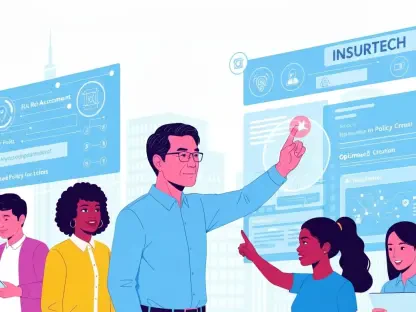In an era where digital interactions dominate daily life, the insurance industry faces a persistent challenge: capturing and retaining customer attention in a sector often perceived as complex and unengaging. Traditional methods of communication, filled with jargon and transactional exchanges, frequently leave policyholders disconnected from their providers. However, a transformative approach is emerging through the integration of gamification into insurance mobile applications. By incorporating game-design elements such as points, badges, and challenges, insurers are redefining user experiences, making routine tasks enjoyable and fostering deeper connections. This innovative strategy not only tackles disengagement but also educates users about risk management in an interactive way. As a result, gamification is becoming a powerful tool to revolutionize how customers interact with insurance services, turning mundane processes into rewarding journeys that encourage sustained app usage and loyalty.
Transforming Routine Tasks into Engaging Experiences
Gamification breathes new life into the often tedious aspects of insurance management by infusing everyday interactions with a sense of achievement and fun. Tasks like policy reviews, claims submissions, or even learning about coverage options are no longer burdensome when paired with game-like mechanics. Points systems provide immediate feedback as users complete actions, creating a gratifying sense of progress with each step. Badges serve as virtual trophies for reaching milestones, while challenges break down complex processes into manageable, goal-driven activities. For example, a module guiding users through policy details might be framed as a quest, with rewards unlocking as knowledge is gained. This approach shifts the perception of insurance apps from mere utilities to dynamic platforms where users feel motivated to return. By tapping into intrinsic human desires for recognition and accomplishment, insurers ensure that customers remain actively involved, transforming what was once a chore into an engaging digital experience.
Beyond the mechanics, the social elements of gamification further amplify user engagement by fostering a sense of community and friendly competition. Leaderboards, for instance, allow users to compare their progress in areas such as wellness goals or safe driving habits with peers, sparking a competitive spirit that encourages consistent app interaction. This social dynamic not only makes the experience more enjoyable but also builds a network of shared goals among users. Additionally, personalized challenges tailored to individual needs keep the content relevant, ensuring that users see direct value in their participation. Such strategies create a cycle of interaction where customers are not just passively consuming information but actively contributing to their journey. The result is a deeper emotional connection to the app, as users begin to associate insurance tasks with positive reinforcement and social interaction, ultimately leading to higher retention rates and more frequent engagement with the platform.
Fostering Risk Awareness Through Behavioral Incentives
One of the most compelling benefits of gamification in insurance apps lies in its ability to enhance risk awareness by encouraging proactive behavior among policyholders. Across various insurance sectors, game-like features are strategically used to educate users about potential hazards while rewarding actions that mitigate those risks. In auto insurance, telematics-driven apps monitor driving patterns such as speed or braking habits, offering points or discounts for safe practices. Similarly, health insurance apps integrate with wearable devices to set daily fitness or mindfulness goals, linking achievements to premium reductions or other perks. These incentives not only make users more conscious of their behaviors but also align their actions with the insurer’s goal of reducing claims. By turning risk management into a rewarding game, insurers empower customers to take control of their safety, creating a partnership dynamic that benefits both parties through lower risks and costs.
Gamification also plays a crucial role in property and casualty insurance by using interactive tools to highlight environmental or structural vulnerabilities. Quizzes and checklists within apps can educate homeowners about fire safety or flood preparedness, with rewards offered for completing preventive measures or adopting smart home technologies. This approach transforms passive policyholders into active participants who understand the importance of safeguarding their assets. Furthermore, the data generated from these interactions provides insurers with valuable insights into customer behavior, enabling more accurate risk assessments and personalized offerings. The continuous feedback loop created by gamified experiences ensures that users remain engaged in managing their risks over time. As a result, insurers position themselves as trusted advisors rather than mere financial backstops, fostering a culture of prevention that enhances customer trust and reduces the likelihood of costly claims.
Building Long-Term Loyalty with Strategic Innovation
The shift toward gamification in insurance apps represents more than a passing trend; it is a strategic move to cultivate lasting customer relationships in a highly competitive digital landscape. By moving away from dense, legalistic communication and limited touchpoints, insurers create personalized, game-driven experiences that resonate with users on an emotional level. Engaged customers who find value and enjoyment in app interactions are far more likely to remain loyal to their providers. Additionally, the behavioral data collected through gamified features allows insurers to refine their products and tailor solutions to individual needs, further strengthening customer satisfaction. This dual focus on engagement and personalization ensures that users view their insurer as a partner in their well-being, rather than just a service provider, paving the way for sustained loyalty in an industry often challenged by churn.
Looking at the broader impact, gamification has proven its worth in aligning customer behavior with business objectives like risk reduction and cost efficiency. Over the years, insurers who adopted these strategies saw a marked decrease in claim frequency as users embraced safer habits through incentivized programs. The interactive nature of gamified apps also led to richer datasets, which helped refine underwriting processes and improve profitability. Reflecting on these outcomes, it became clear that gamification was not just about enhancing user experience but also about driving tangible business results. As the digital environment continues to evolve, the next steps involve integrating emerging technologies like artificial intelligence to further personalize gamified experiences. Insurers are encouraged to explore these innovations, ensuring that gamification remains a cornerstone of customer engagement strategies, setting a benchmark for success in a rapidly changing market.









